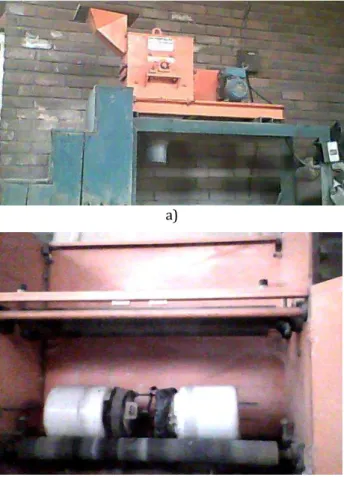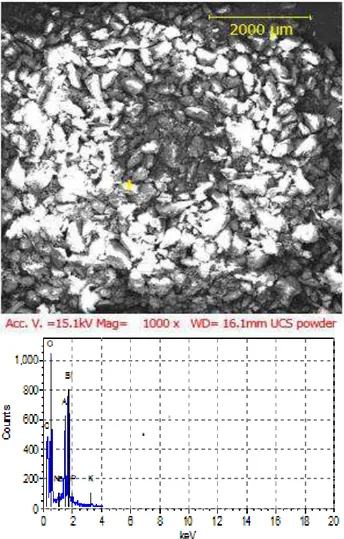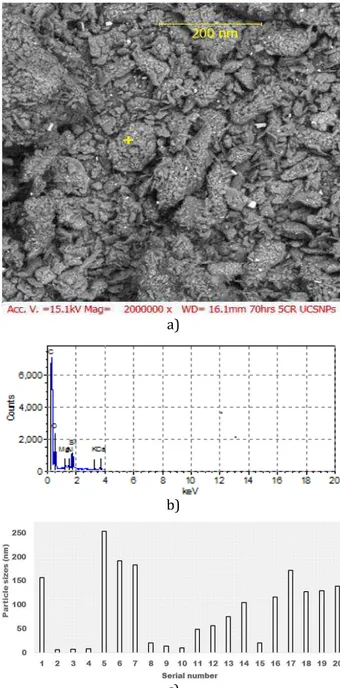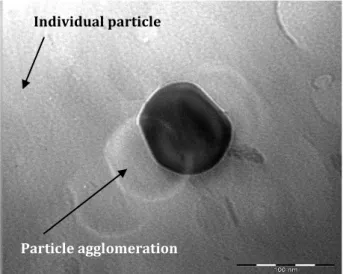Tribology in Industry
www.tribology.fink.rs.fink.rs
Synthesis of Uncarbonised Coconut Shell
Nanoparticles: Characterisation and Particle Size
Determination
S.A. Bello
a,b, S.B. Hassan
a, J.O. Agunsoye
a, M.G. Zebase Kana
b, I.A. Raheem
aaDepartment of Metallurgical and Materials Engineering, Faculty of Engineering, University of Lagos, Lagos, Nigeria, bDepartment of Materials Science and Engineering, College of Engineering and Technology, Kwara State University,
Malete, Nigeria.
Keywords:
Coconut shell Nanoparticles Microscope Mechanical milling Agglomeration
A B S T R A C T
The possibility of using mechanical milling for the synthesis of uncarbonised coconut shell nanoparticles (UCSNPs) has been investigated. UCSNPs were synthesized from discarded coconut shells (CSs) using top down approach. The sundried CSs were crushed, ground and then sieved using hammer crusher, a two disc grinder and set of sieves with shine shaker respectively. The CS powders retained in the pan below 37 µm sized sieve were milled for 7 hours to obtain UCSNPS. Samples for analysis were taken at 16 and 70 hours. UCSNPs were analyzed using transmission electron microscope (TEM), scanning electron microscope (SEM) with attached EDS and Gwyddion software. Samples of UCSNPs obtained at 16 and 70hours show that the deep brown colour of the initial CS powder became fading as the milling hour increased. The size determination from TEM image revealed spherical particles with an average size of 18.23 nm for UCSNPs obtained at 70 hour milling. The EDS spectrographs revealed an increase in the carbon counts with increased milling hours. This is attributable to dryness of the CS powders by the heat generated during the milling process due to absorption of kinetic energy by the CS powders from the milling balls. SEM micrographs revealed UCSNPs in agglomerated networks. The SEM micrograph/Gyweddion particles size determination showed average particles of 170.5 ± and .9 ± . nm for UCSNPs obtained at 16 and 70 hours respectively. Therefore, production of UCSNPs through mechanical milling using mixture of ceramic balls of different sizes has been established especially when the particles of the sourced/initial CS powders falls below 37 µm.
© Published by Faculty of Engineering Corresponding author:
S.A. Bello
Department of Materials Science and Engineering,
College of Engineering and Technology,
Kwara State University, Malete, Nigeria.
E-mail: sefiu.bello@yahoo.com
1. INTRODUCTION
The use of agricultural wastes as a source of raw materials most especially reinforcements for a
composite production is the new emerging area of technological advancements [1]. A lot of researches all over the world are now concentrating on studying the potentials of agro
R
E
S
E
A
R
C
wastes for reinforcement purposes. This will not only provide alternate reinforcements for highly expensive synthetic glass and carbon fillers but also leads to environmental cleanliness and wealth creation through foreign exchange earnings.
Currently, natural fillers obtained from coconut shell, palm kernel shell, periwinkle, banana peel, wall nut shell, maize stalk, eggshells and rice husk have been used for reinforcement in composite productions [2-5]. Many researchers reported the use of the natural fillers at micro sized level for instance Agunsoye et al. (2014) [6] reinforced recycled polypropylene with 80 and µm sized coconut shell particles for composite productions. Bello (2014) [7] used coconut shell particles of different particle sizes (300, 215, 150, 75 and 50 µm) for the production of aluminium can/coconut shell composites. Baskar and Singh (2013) [8] produced epoxy resin based composites with 80- µm sized coconut shell particles as reinforcements. Sarki et al. (2011) [5] produced epoxy resin based composites using 50 µm sized coconut shell particles as reinforcements. Idris et al. 2013 [9] used 100 µm sized banana peel particles for the production of ecofriendly asbestos free brake pad. Oghenevweta et al. (2014) [10] used 53 µm maize stalk as reinforcement for the production of Al-Si – Mg/carbonised maize stalk composites. Reports from most of these researches indicated reduction in impact energy of the produced composites which is attributed to inherent brittleness of the agro fillers within the micro level. The potentials of the agro waste as reinforcing fillers can be enhanced by further processing into nanometric level since particles within the nanoscale possess some promising properties such as ductility of nanoceramic, cold welding of nanometal particles, combined high strength, ductility and toughness of nanoparticles which are very rare with materials within micro level.
In the synthesis of nanoparticles, a different technique which includes physical vapour deposition, chemical vapour deposition and mechanical milling have been implored [11-13]. The large scale production at a faster rate has been attributed to mechanical milling although nanoparticle synthesis through this approach requires proper monitoring of milling
parameters such as charge ratio, rate of rotation of vial, brittleness of materials, milling duration, size of the milling balls and materials of which the balls are made [1, 11-13]. In contrast with literatures, many works have done on the production of coconut shell microparticles through mechanical milling. However, synthesis of coconut shell nanoparticles through top down approach (mechanical milling) is rare or not being found. In this current work, an uncarbonised coconut shell nanoparticle has been synthesized. The significance of this work is to devise further means of adding values to CSs. The work was aimed at synthesis of UCSNPs that will be used as one of fillers for a fabrication of polymer based hybrid nanocomposites.
2. MATERIALS AND EQUIPMENT
Materials used in this work were uncarbonised coconut shells (UCS) which were obtained from maize/coconut sellers at Yaba Lagos. Equipment used includes planetary ball mill, hammer crusher, disc grinder, set of sieves with a sine shaker, weighing scale, scanning electron microscope with attached EDS/Gwyddion software and transmission electron microscope.
3. METHODOLOGY
The UCS were sundried for two months after which they were broken into smaller pieces with the aids of hammer crusher. The crushed UCS pieces were ground using a two disc grinder to obtain UCS powders which they were sorted into different sizes using set of sieves arranged in descending of grain fineness number. The sieves were shaken for 40 minutes using a sine shaker. The sieve sizes range from 650 to 37 µm. The UCS powders retained in the pan below 37 µm were used as UCS powders for uncarbonised coconut shell nanoparticles synthesis (UCSNPs).
analyzed to determine the particle sizes. The morphology, chemical and particle size determination analyses were carried out using transmission electron microscope (TEM), scanning electron microscope with attached EDS and Gwyddion software.
a)
b)
Fig. 1. Photographs of coconut and its shells (a) sliced coconut (b) unbroken CSs (c) broken CSs.
a)
b)
Fig. 2. Crushing/milling machine (a) hammer crusher (b) planetary ball mill.
Figures 1 present sliced coconut and coconut shells in different forms while Fig. 2 present the hammer crusher and planetary ball mill with the E3 sized vial. Table 1 displays the milling parameters used in this work.
Table 1. Milling parameters.
Charge ratio (CR) 5
Rate of rotation 195
Material of the ball Ceramic
Size (mixture of balls) 5 to 60mm
Mass of the balls 2kg
Mass of the CS 400
4. RESULTS AND DISCUSSIONS SEM
MICROGRAPHS AND EDS SPECTROGRAPHS
Br, Zr, W and Au have too low count scores that they cannot have distinct peaks on the EDS spectrograph. They are represented by spectrum around K peak. Non-metallic elements, C, O and phosphorus confirm the presence of lignin, cellulose and pentosans in the CS while the detected metals confirm the mineral contents of the CS.
Fig. 3. SEM micrograph/EDS spectrograph of the UCS powder.
Figure 4 shows the SEM micrograph and EDS spectrograph of the uncarbonised coconutshell nanopaticles obtained at 16 hour of milling and 5 charge ratio. The microstructure in Fig. 4a reveals many agglomerated networks of extremely fine particles and few discrete fine particles. The particle agglomeration may be attributable to particle high surface energy leading to physical interaction (cold welding) among the particles. During the process of milling, the particle breakage leads to increased surface area (high surface energy) which enhanced the agglomeration of very fine particles in order to seek minium possible energy.
EDS spectrograph on Fig. 4b reveals the same elements (see Table 3) as in Fig. 3 and Table 2 except Ca which is absent in Table 2. The presence of Ca may be attributable to impurity from milling balls. Also, there is an enhancement in the % composition of C with proportionate reduction in % composition of O, Al, Si. It is a result of evaporation of moisture during the milling process. The heat generated due to impacts among milling balls, particles and wall of the vial is sufficiently high to cause the evapoartion of the particles.
The white particles are attributable to presence of Al, Ca, Na and K in the CS. The particle size analysis using SEM supported with Gwyddion software indicated that the UCSNP size ranges from 68.3 to 512.5 nm with mean particle size of . ± nm. Figure c shows the sizes of 20 particles manually measured from SEM micrographs.
Table 2. EDS Chemical analysis of the UCS powder.
Elements C O Al Si Na P K Br Zr W Au
% comp 23.76 32.11 19.57 23.54 3.06 3.06 1.53 0.37 0.09 0.79 0.12
Table 3. EDS Chemical analysis of the UCSNPs at 16hours and 5CR.
Element C O Si Al Ca Na W Zr Au K P
% Comp 59.44 17.58 11.91 9.55 0.04 0.04 0.12 0.08 0.06 0.08 1.1
Table 4. EDS Chemical analysis of UCSNPs obtained at 70 hours and 5CR.
Element C O Si Al Ca K Na Mg W Fe Au P
a)
b)
c)
Fig. 4. (a) SEM micrograph, (b)EDS spectrograph, (c) particle sizes of UCSNPs obtained at 16 hour and 5 charge ratio.
Figure 5a presents the SEM micrograph at very high magnification while Fig. 5b shows EDS spectrograph of the UCSNPs obtained after 70 hour milling at 5charge ratio. The microstructure on Fig. 5a shows extremely fine particles fused together to form a high degree network of agglomerations. This is an indication of progressive particle breakage and cold welding as the milling hours increased. The EDS spectrograph shows C, O, Si and other elements with highest count scores when compared with EDS spectrographs on Fig. 2 and 3b.
a)
b)
c)
Fig. 5. (a) SEM micrograph, (b) EDS spectrograph of UCSNPs obtained at 70 hours and 5cr,(c) particle sizes.
companied with change in their colours. The SEM/Gwyddion particle size analysis revealed maximum and minimum particle sizes of 258.3 and 6.06 nm respectively while the average particle diameter is . ± . nm. Figure c displayed the particle size of 20 particles measured manually from the SEM micrograph by drawing a vertical line perpendicular to the base to the top of the coconut shell nanoparticle grains.
4.1Tem Micrograph
Figure 6 presents the TEM micrograph of the UCSNPs obtained at 7 hour milling and 5 charge ratios at 100 nm resolution. The micrograph on Fig. 5 shows many individual particles in spherical form with few particle agglomerations. The sizes of individual particles were determined by height of the particles in the TEM image by a perpendicular line drawn from the flat base of the CCSNPs to their top. The average estimated particle size is . ± . nm. This is smaller than what is obtained from SEM/Gwyddion analysis. This confirms that size obtained from SEM/Gwyddion is the grain size rather than the particle size.
Fig. 6. TEM image of UCSNPs obtained at 70 hours milling and 5 CR.
5. CONCLUSION
From results of investigation and discussion of this research work, the following conclusions can be established:
1. UCSNPs have been produced through mechanical milling at 5 charge ratio and prolonged milling duration.
2. The produced UCSNPs would serve as alternative reinforcement to synthetic fillers such as carbon nanotubes in polymer and metal matrices for composite productions.
3. The particle sizes decreased with increasing milling durations.
4. Breakage of particles occurred simultaneously with particle agglomeration as the milling time increased.
5. The increased carbon count score (% composition) at higher milling hour is attributable to heat generated leading to evaporation of moisture contents of the CS.
6. The use of mixture of different diameter ceramic balls is effective in the synthesis of high purity UCSNPs (0.7 % impurity due to Ca presence) especially when the size of the initial CS powder is below 37 µm.
7. Hence, additional means of adding values to CSs have been established.
8. The potential of using UCSNPs as reinforcements for the fabrication of polymer matrix hybrid nanocomposites for engineering application is under study. Results from the study will be presented in the future publication.
Acknowledgements
Authors wish to appreciate Mrs Haneefah A. Bello for the sponsorship of this research work. Also appreciated are Mr Rasheed Abiodun Jimoh and Mr Abdul Wahab Abass Olayinka of Department of Materials Science and Engineering for their assistance in carrying out microstructural analysis.
REFERENCES
[1] S.A. Bello, 'Study of Mechanical and Thermal Resistance Properties of Epoxy Resin based Hybrid Nanocomposites', PhD thesis, Department of Metallurgical and Materials Engineering, University of Lagos, Nigeria, 2015. [2] J.O. Agunsoye, S.A. Bello, I.S. Talabi, A.A. Yekinni,
I.A. Raheem, A.D. Oderinde and T.E. Idegbekwu, 'Recycled Aluminium Cans/Eggshell Composites: Evaluation of Mechanical and Wear Individual particle
Resistance Properties', Tribology in Industry, vol. 37, no. 1, pp. 107-116, 2015.
[3] J.O. Agunsoye, S.I. Talabi, S.A. Bello and I.O. Awe, 'The Effects of Cocos Nucifera (Coconut Shell) on the Mechanical and Tribological Properties of Recycled Waste Aluminium Can Composites', Tribology in Industry, vol. 36, no. 2, pp. 155-162, 2014.
[4] S.B. Hassan, V.S. Aigbodion and S.N. Patrick, 'Development of Polyester/Eggshell Particulate Composites', Tribology in Industry, Vol. 34, no. 4, pp. 217-225, 2012.
[5] J. Sarki, S.B. Hassan, V.S. Aigbodion and J.E. Oghenewevweta, 'Potential of using coconut shell particle fillers in eco-composites materials', Journal of Alloys and Compounds, vol. 506, pp. 2381-2385, 2011.
[6] J.O. Agunsoye, S.A. Bello, S.O. Azeez, A.A. Yekinni and R.G. Adeyemo, 'Recycled Polypropylene Reinforced Coconut Shell Composite: Surface Treatment Morphological, Mechanical and Thermal Studies', International Journal of Composite Materials, vol. 4, no. 3, pp. 168-178, 2014.
[7] S.A. Bello, 'Development and Characterization of Aluminium Can/Coconut shell Composites', Master of Science Thesis, Department of Metallurgical and Materials Engineering, University of Lagos, Nigeria, 2014.
[8] J. Baskar and V.S. Singh, 'Water Absorption and Compressive Properties of Coconut Shell Particle Reinforced-Epoxy Composite', J. Mater. Environ. Sci., vol. 4, no. 1, pp. 113-118, 2013.
[9] U.D. Idris, V.S. Aigbodion, I.J. Abubakar and C.I. Nwoye, 'Eco-friendly asbestos free brake-pad: Using banana peels', Journal of King Saud University - Engineering Sciences, vol. 27, no. 2, pp. 185-192, 2015.
[10] J.E. Oghenevweta, V.S. Aigbodion, G.B. Nyior and F. Asuke, 'Mechanical Properties and Microstructural Analysis of Al-Si-Mg/Carbonised Maize Stalk Waste Particulate Composites', Journal of King Saud University – Engineering Sciences, In Press, Corrected Proof-Note to users, 2014.
[11] J. Raphael and G. Daniel, 'Ball-milling in Liquid Media Applications to the Preparation of Anodic Materials for Lithium-Ion Battery', Progress in Materials Science, vol. 50, no. 1, pp. 1-92, 2005.
[12] T.P. Yadav, R.M. Yadav and D.P. Singh, 'Mechanical Milling: a Top Down Approach for the Synthesis of Nanomaterials and Nanocomposites', Nanoscience and Nanotechnology, vol. 2, no. 3, pp. 22-48, 2012.



